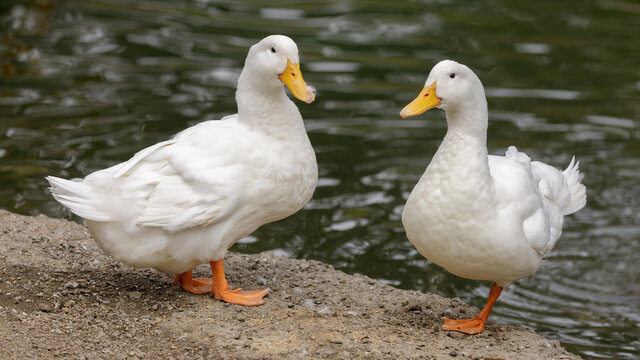American Pekin

Scientific Name
Anas platyrhynchos
Alternative Names
Pekin, White Pekin, Long Island Duck
Measurements
| Feature | Male | Female |
|---|---|---|
| Length | About 50–60 cm (20–24 in) | About 50–60 cm (20–24 in) |
| Weight | 4.5 kg (10 lb) | 4.1 kg (9 lb) |
| Wingspan | Around 85–95 cm (33–37 in) | Around 85–95 cm (33–37 in) |
Status
Listed as “not at risk” by the Food and Agriculture Organization (FAO, 2007). The breed is raised worldwide and remains one of the most common domestic ducks, especially for meat production.
Identification
A large, sturdy duck with a broad, rectangular body held at a slight angle. It has creamy-white plumage, yellow-orange legs and feet, and a bright yellow bill. The head is rounded, and the neck is thick. Its smooth breast and clean white feathers make it ideal for meat production.
Voice
Produces soft quacks and low grunts. Males are quieter, while females make the louder, more typical duck sounds.
Diet
Fed mainly on grains, commercial duck feed, greens, and small insects. They grow quickly and have a high feed-to-meat conversion rate.
Distribution
Originally from the United States, now bred across the world for meat and eggs.
Habitat
A domestic breed commonly found on farms and in managed ponds. Adapted to a wide range of climates and raised both commercially and by small-scale farmers.
Breeding
Lays more than 150 white or tinted eggs each year. Not a good sitter, so eggs are usually incubated artificially. The breed grows rapidly, reaching around 3.5 kg (8 lb) in about seven weeks. Selective breeding focuses on growth, size, and lower fat content.
Wintering
Fully domestic and non-migratory. Comfortable in a range of climates when provided with proper shelter.
Conservation
Not considered threatened. Widely kept and bred around the world for meat, eggs, and showing. Its strong population and commercial value ensure its long-term stability.
